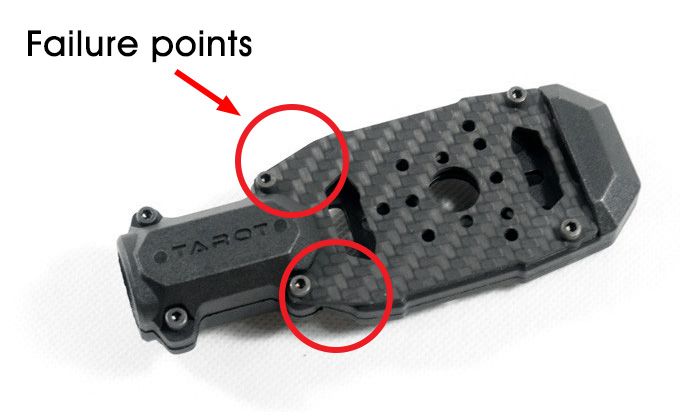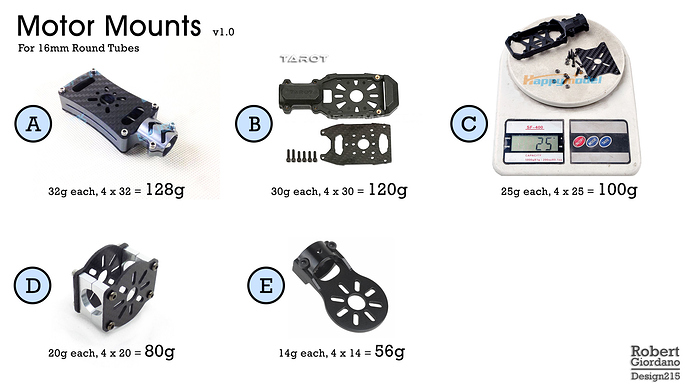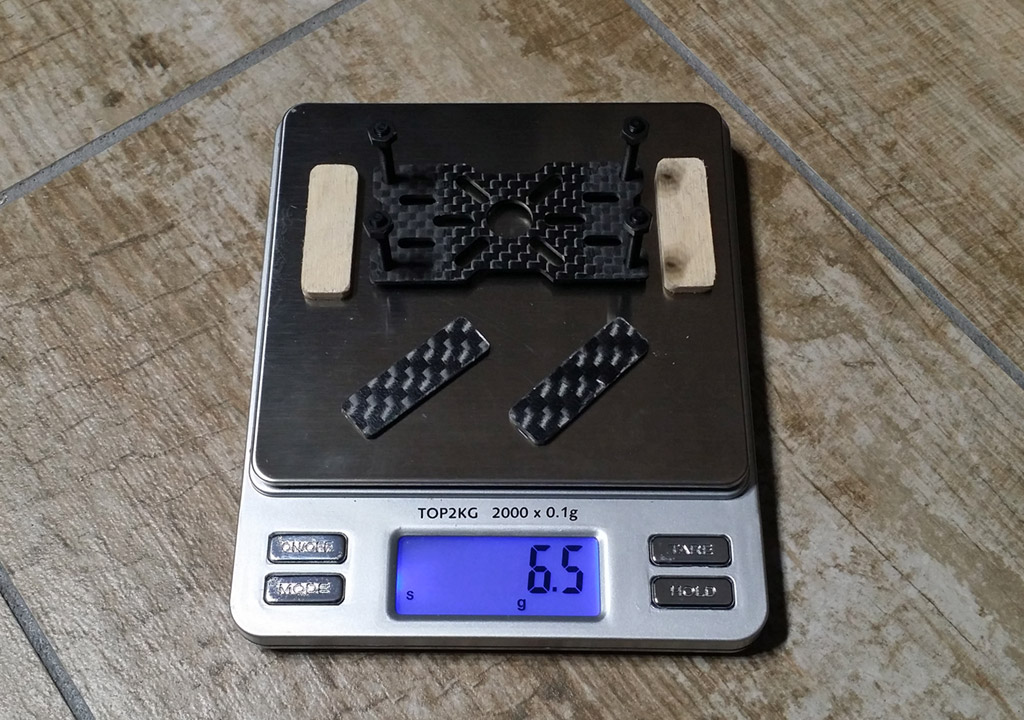08 - Motor Mounts… Please Help!
I’ve looked at quite a few motor mounts and I’ve done a number of experiments. We really need more choices in this department. I have some ideas but I don’t have a 3D printer. I know some of you do, and hopefully we can work together. At the end of this post I think I’ve found a good solution, but let’s see how I got there…
This is what I found on the internet for 16mm round tubing. I selected 16mm because it seems to be the most popular. One of the problems I face is, I don’t see many choices if I want to use 18mm or 20mm tubing. Most of the mounts I saw were variations on one of these five. They’re sorted by weight.
OMG, Those mounts are HEAVY!
I designed and built a 680mm frame that only weighs 140g and now I need to add another 100g just for motor mounts? No thanks.
Mount D
I like this style mount because you can use it for an X8 and if you’re only building a quad, you can leave off one of the motor plates. One plate and 4 screws is usually 3-4 grams so 16x4 = 64g isn’t so bad. But it’s not light enough for me.
Mount E
Even though this mount is lighter, I don’t like it. You can’t use it for an X8 and in a crash, it will be weaker than Mount D. Mounts B, C, and E all have a weak point where the tube connector meets the motor plate. Even the Tarot mount has a similar weak point. Look at how little material there is between the tube connector and the motor plate. A heavy motor attached to that plate will act as a lever and guess where its gonna break?
EDIT 2018/04/26: This paragraph is about Mount E and I should have used the picture of Mount E instead of the following picture of the Tarot mount because; a) I haven’t used the Tarot mount myself, and b) According to the community, the Tarot mount is pretty strong. That being said, everyone agrees the Tarot mount is heavy and I do have lighter solutions that are just as strong if not stronger.

3D Printed Mounts
My previous ship used 3D printed motor mounts. They were designed and printed by a friend in another group. He made several sets of them and they are quite excellent:
Each mount is glued to the tube with epoxy. Because they are glued together over the surface of the tube, they strengthen each other as one solid piece. Each mount AND the epoxy weighs 8g, for a total of 32g!
So, what’s the downside?
- They were designed for a very specific, 15.26mm OD tubing. Yes, I might be able to modify the 3D file and have them printed for 16mm tubing, but then I wouldn’t have clearance for the bolts that go into the motor.
- They won’t work for motors with a different bolt pattern.
- They won’t work for an X8.
So, I want to make something different. But these 3D printed mounts have certainly set the bar on weight and strength!
Recent Experiments
I’ve been playing with the motor mounts that came with my H4 Alien 680mm frame. They are very similar to mount D above. They can be used for a quad or an X8. I like the separate carbon fiber motor plates because they allow for a variety of motor sizes and bolt patterns, and they can be changed if they break.
At 20g each, that’s 80g added to my frame instead of 32g for the 3D printed mounts. Let’s see what we can do with these Alien680 mounts…
Here’s all four mounts with one motor plate removed and the four screws for each plate. Now each mount weighs 15.5g. But I’m not done…
Now each mount weighs 11.7g! All I did here was switch to nylon bolts. I’ve been using nylon bolts for years and I’ve never had a problem. But I know what you’re thinking-- I won’t be able to tighten the nylon bolts enough to clamp the mount to the tube. You’re right! And, I’m not going to use the bolts to clamp the mounts to the tube. I’ll use a little epoxy between the red halves and the tube. I will never have to worry about my motor mounts rotating out of square. The nylon bolts will simply hold the motor plates. I can take the motor plates on and off without having to level the mounts each time.
Can I go further? Hmmm…
Here I am at 32g, the same as my 3D printed mounts! But wait, I don’t like it. Now I only have half the surface area to epoxy to the tubing and I don’t have the safety of the nylon bolts. Even though the bolts aren’t clamping the mount to the tube, they still go through both halves, making a solid ring around the tube. The bolts pass through one half with no threads, into the other half that’s threaded all the way through. So far, the 46g solution looks the best.
But what if…
What if I used the lighter halves of the red tube clamp (the ones with no threads) and cut some pieces of carbon fiber plate (10mm x 32mm x 2mm) for the bottom side of the tube? The answer is 8.8g each, or 35.2g total! And, now I have some safety once again because the mounts are held on by epoxy and by the nylon bolts running through my carbon fiber plates on the other side of the tube. If I want to change it to X8, I can just use the other halves of the tube clamps and I’ll be back to the 46g configuration.
If you’re worried about the nylon nuts coming loose, use a little CA glue. If you need to remove them, you can cut the nylon bolts like you would a zip tie. Personally, I don’t worry about nylon bolts coming loose. They are naturally self-locking. I’ll probably do a separate post just on nylon bolts.
What about square tubing?
Well, I’ve been thinking more and more about square tubing. As it turns out, the previous solution works even better for square tubing…
There you go! 6.5g each and only 26g total! All I did here was replace the aluminum tube brackets with 10mm x 32mm pieces of 1/8" birch plywood. Sorry I didn’t drill holes for the picture but you would run the bolts through the wood, which just acts as a spacer for the motor shaft and its bolts. The mount bolts continue though the carbon fiber plates on the underside of the square tubing. The wood spacers are easily epoxied to the tube because both surfaces are flat. If you’re only building a quad, I would epoxy the carbon fiber plates as well.
Here’s where I need your help…
Looking at all of this, I think a great solution would be 3D printed “rings” that are similar in size as the red aluminum tube clamps. But instead of each side being two halves, each side would be single “ring” that slides over the tube and is epoxied in place. The rings don’t need threads, just a hole on each side. Bolts would run through the rings, then through the motor mount plate, and secured with nuts. The carbon fiber plates on the bottom are no longer needed.
Rings could be printed for different sizes of tubing, including square. If you’re building an X8, you would just add a second motor plate.
If any of you would like to help me make some of these, please let me know. I don’t have a 3D printer and I don’t have any of the software people use to print things. I can create nice looking 3D models in Blender if that helps. I think this system could work really well. It would be stronger and SO much lighter than anything else I’ve seen!
Where do I get nylon bolts?
Local hardware stores have them but you’ll pay a lot. The best place I’ve found is McMaster-Carr. Here’s an example: Nylon M3 x 0.5mm thread, 20mm long, black, $7.87 for a pack of 100.







